Mindfulness practices can significantly reduce stress and enhance emotional regulation. This article explores applications like mindfulness-based stress reduction, highlights universal benefits such as improved mental clarity, and examines various workshop options available for learning these techniques. Additionally, it discusses unique and rare attributes that can enrich mindfulness experiences.
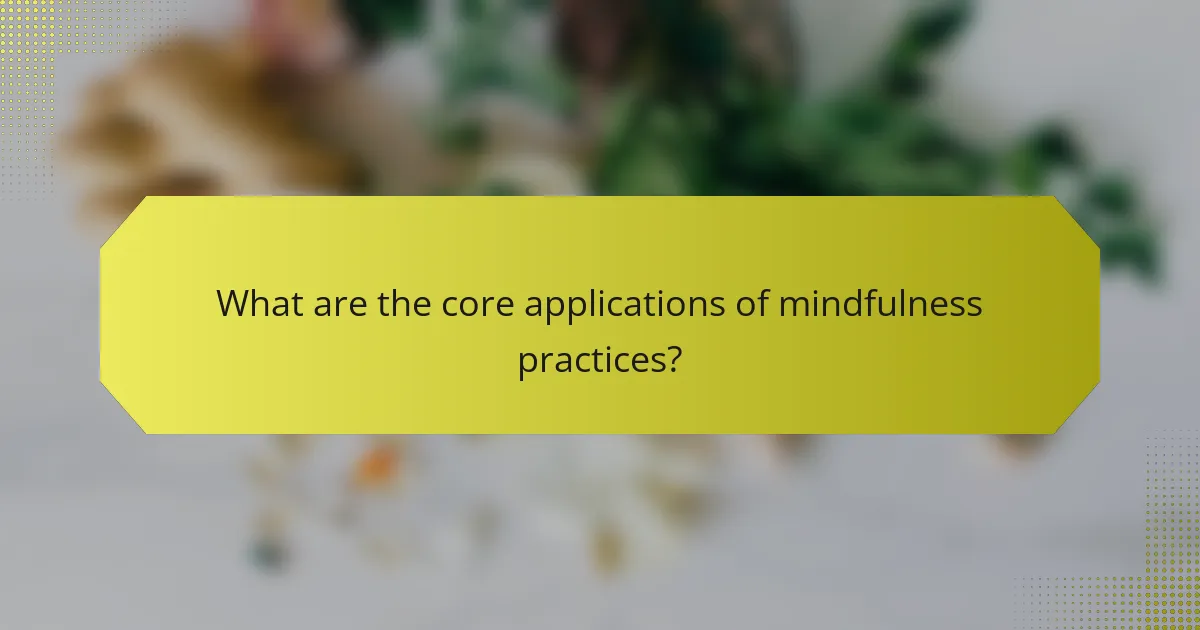
What are the core applications of mindfulness practices?
Mindfulness practices are applied in various areas including stress reduction, emotional regulation, and enhancing focus. These practices improve mental clarity, promote well-being, and foster resilience. Common applications include mindfulness-based stress reduction (MBSR), mindfulness meditation, and mindful eating. Research shows that regular practice can lead to significant reductions in anxiety and depression symptoms. Additionally, mindfulness workshops offer structured environments for individuals to learn and integrate these practices into daily life.
How do mindfulness practices enhance mental well-being?
Mindfulness practices significantly enhance mental well-being by reducing stress, improving focus, and promoting emotional regulation. Regular engagement in techniques such as meditation and deep breathing can lead to measurable improvements in mental health metrics. Research indicates that mindfulness can decrease anxiety levels by up to 30% and improve overall life satisfaction. Additionally, mindfulness fosters a unique awareness of thoughts and feelings, allowing individuals to respond rather than react to stressors. This practice encourages resilience, making it a valuable tool for maintaining mental health.
In what ways can mindfulness practices improve workplace productivity?
Mindfulness practices can significantly enhance workplace productivity by reducing stress and improving focus. Employees who engage in mindfulness techniques report better concentration and increased job satisfaction. Studies indicate that organizations implementing mindfulness training see a notable decrease in absenteeism and a boost in overall performance. Regular practice fosters a culture of well-being, leading to improved collaboration and creativity among team members.
What role do mindfulness practices play in educational settings?
Mindfulness practices enhance educational settings by improving focus, reducing stress, and fostering emotional regulation. These practices, such as meditation and breathing exercises, promote a positive learning environment. Research indicates that students engaged in mindfulness show increased academic performance and better social interactions. Workshops focusing on mindfulness can provide educators with effective strategies to implement these practices in their classrooms, benefiting both students and teachers.
How can mindfulness practices support emotional regulation?
Mindfulness practices enhance emotional regulation by promoting awareness and acceptance of emotions. Techniques like meditation and deep breathing reduce stress and improve emotional clarity. Research indicates that regular mindfulness can lead to a 30% increase in emotional resilience. This unique attribute of mindfulness allows individuals to respond to emotional triggers more effectively, fostering healthier relationships and improved mental health.
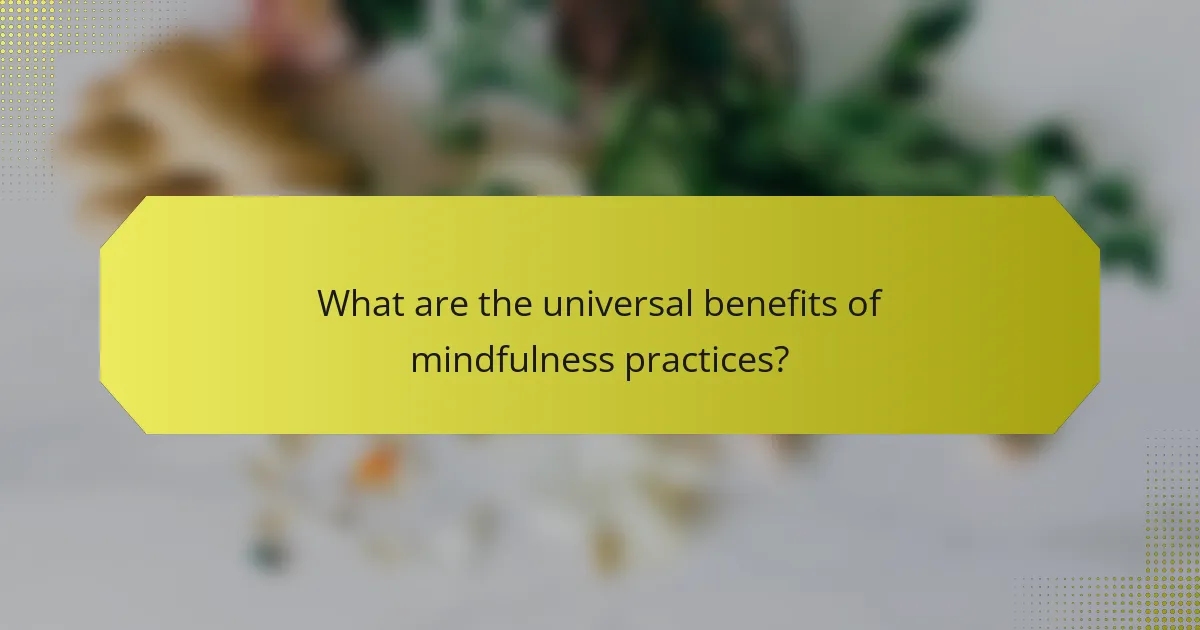
What are the universal benefits of mindfulness practices?
Mindfulness practices offer numerous universal benefits, including improved mental clarity, reduced stress, and enhanced emotional regulation. These practices foster greater self-awareness and promote overall well-being. Research indicates that regular engagement can lead to increased focus and better relationships. Additionally, mindfulness can enhance physical health by lowering blood pressure and improving sleep quality.
How does regular mindfulness practice reduce stress?
Regular mindfulness practice significantly reduces stress by promoting relaxation and enhancing emotional regulation. Studies show that individuals who engage in mindfulness techniques experience lower cortisol levels, which is a key stress hormone. This practice encourages present-moment awareness, allowing individuals to detach from stressors. Additionally, mindfulness fosters resilience, enabling better coping strategies in challenging situations. Over time, consistent practice can lead to lasting changes in brain structure associated with stress response, enhancing overall well-being.
What impact do mindfulness practices have on anxiety levels?
Mindfulness practices significantly reduce anxiety levels by promoting relaxation and enhancing emotional regulation. Techniques such as meditation and deep breathing help individuals focus on the present moment, alleviating stress. Research indicates that regular mindfulness practice can lead to a 30% reduction in anxiety symptoms. Unique attributes of mindfulness include its adaptability to various settings, such as workshops or individual practice, making it accessible for many. As a result, incorporating mindfulness into daily routines can foster long-term mental health benefits.
How can mindfulness practices improve focus and attention?
Mindfulness practices significantly enhance focus and attention. Techniques like meditation and mindful breathing train the brain to minimize distractions and improve cognitive control. Research indicates that regular mindfulness practice can increase attention span and enhance task performance. Workshops focusing on mindfulness often include exercises designed to cultivate awareness, which can lead to long-term improvements in concentration.
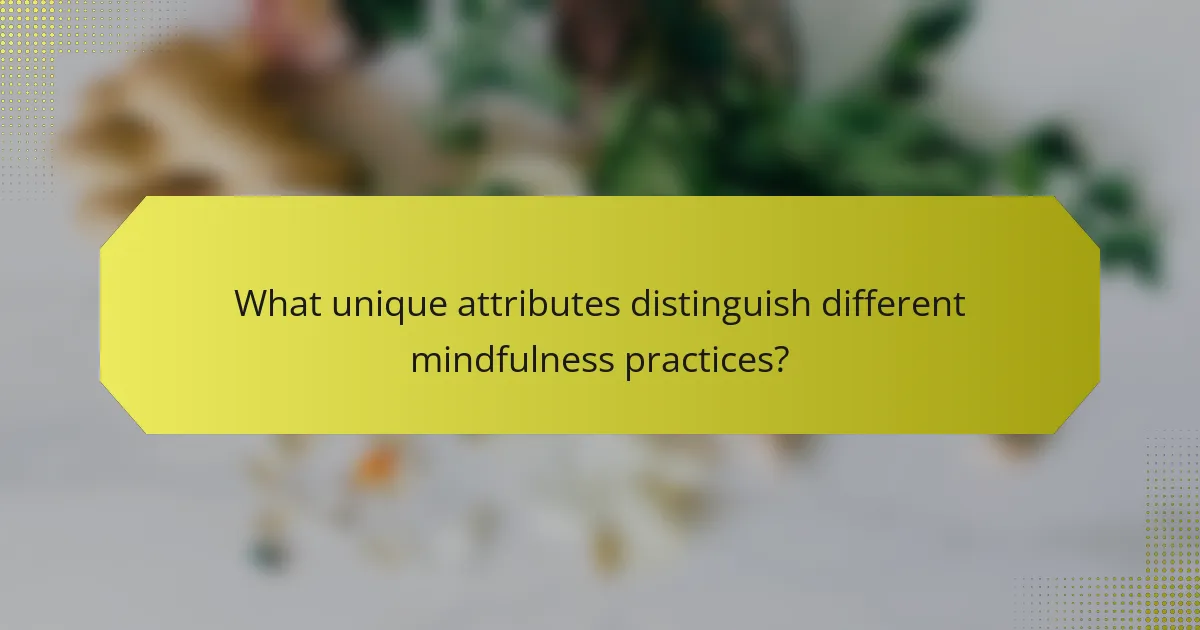
What unique attributes distinguish different mindfulness practices?
Mindfulness practices vary significantly based on their unique attributes. Techniques such as meditation, yoga, and mindful breathing each offer distinct approaches. For instance, meditation often emphasizes mental focus, while yoga integrates physical movement with mindfulness. Unique attributes like the duration of practice and the specific techniques used further distinguish these practices. Additionally, some practices may incorporate elements like sound or visualization, which are less common in others, providing a diverse range of options for individuals seeking mindfulness.
How do guided meditations differ from silent meditations?
Guided meditations provide verbal instructions, while silent meditations focus on personal reflection. Guided practices often enhance mindfulness through structured guidance, making them accessible for beginners. Silent meditations cultivate self-awareness and deeper introspection, appealing to those seeking solitude. Both approaches offer unique benefits, catering to different preferences in mindfulness practices.
What are the unique features of mindfulness-based stress reduction (MBSR)?
Mindfulness-based stress reduction (MBSR) features a structured program that combines mindfulness meditation, body awareness, and yoga. Its unique attributes include an evidence-based approach, fostering self-awareness, and promoting emotional regulation. MBSR typically lasts eight weeks, providing participants with practical tools to manage stress effectively. The program emphasizes experiential learning, allowing individuals to cultivate present-moment awareness through guided practices.
How do cultural backgrounds influence mindfulness practices?
Cultural backgrounds significantly shape mindfulness practices through varying beliefs and traditions. Different cultures emphasize unique techniques, such as Zen meditation in Japan or mindfulness-based stress reduction in the West. These practices reflect cultural values, influencing how individuals engage with mindfulness. For example, collectivist cultures might focus on community-oriented mindfulness, while individualistic cultures may emphasize personal growth. Understanding these influences enhances the effectiveness of mindfulness applications across diverse populations.
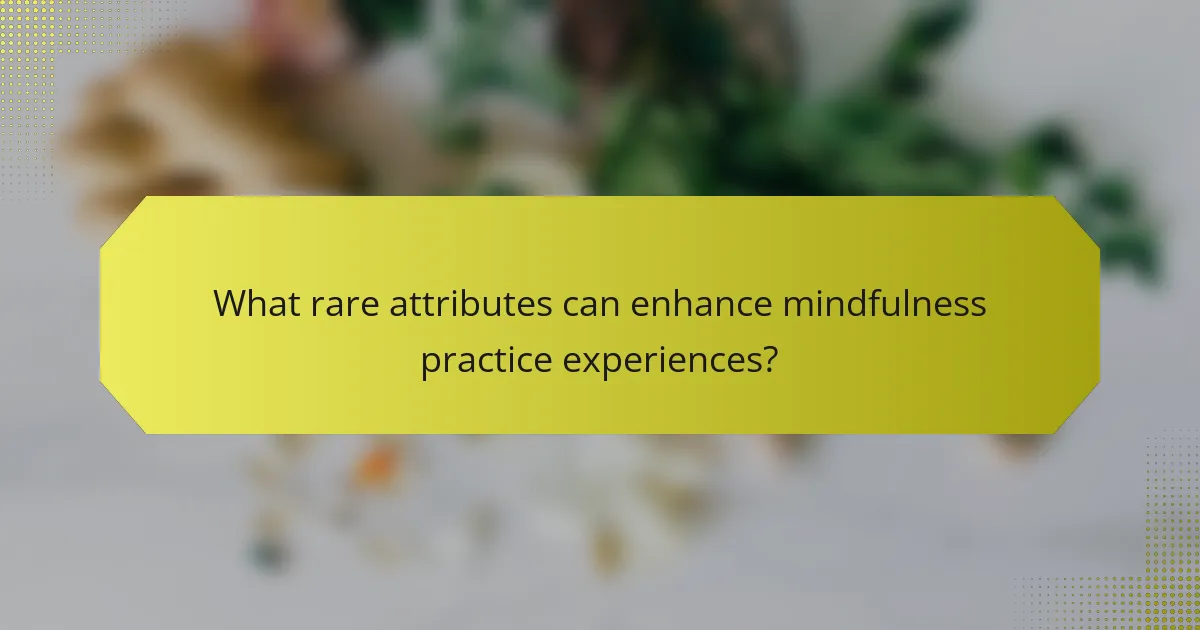
What rare attributes can enhance mindfulness practice experiences?
Rare attributes that can enhance mindfulness practice experiences include nature immersion, sensory deprivation, and personalized soundscapes. Nature immersion connects practitioners with natural environments, promoting deeper relaxation. Sensory deprivation, such as floatation therapy, minimizes distractions, enhancing focus. Personalized soundscapes tailor auditory experiences to individual preferences, fostering a unique meditative state. These rare attributes can significantly enrich mindfulness practices.
How can nature immersion amplify the effects of mindfulness?
Nature immersion significantly enhances mindfulness by promoting deeper relaxation and connection to the present moment. Engaging with natural environments can reduce stress and improve emotional well-being. Research indicates that spending time in nature can increase mindfulness practices, leading to heightened awareness and focus. This unique attribute of nature immersion amplifies the benefits of mindfulness, making it a powerful tool for personal growth and mental health.
What are the benefits of incorporating art into mindfulness practices?
Incorporating art into mindfulness practices enhances emotional expression, reduces stress, and fosters creativity. Engaging with art can deepen focus and promote relaxation, improving overall mental well-being. Studies indicate that art-based mindfulness can increase self-awareness and provide unique pathways for personal insight.

What are the best workshop options for learning mindfulness practices?
Mindfulness practices can be learned through various workshops, each offering unique benefits. Popular options include mindfulness-based stress reduction (MBSR), mindfulness meditation retreats, and online courses. MBSR workshops typically last eight weeks and focus on reducing stress and enhancing well-being. Meditation retreats provide immersive experiences, often lasting several days. Online courses offer flexibility, allowing participants to learn at their own pace. Each workshop type caters to different learning preferences and schedules, helping individuals incorporate mindfulness into their daily lives.
What should I look for in a mindfulness workshop?
When selecting a mindfulness workshop, prioritize experienced instructors, workshop structure, and participant feedback. Look for workshops that offer practical applications of mindfulness, such as stress reduction techniques or emotional regulation strategies. Consider the duration and frequency of sessions to ensure they fit your schedule. Unique attributes like specialized themes, such as mindfulness for anxiety or corporate settings, can enhance your experience. Lastly, check for post-workshop support options to sustain your practice.
How do online versus in-person mindfulness workshops compare?
Online mindfulness workshops offer flexibility and accessibility, while in-person workshops provide direct interaction and community engagement. Both formats have unique benefits that cater to different preferences.
| Attribute | Online Workshops | In-Person Workshops |
|———————-|—————————|—————————|
| Accessibility | High | Moderate |
| Interaction | Limited | Direct |
| Cost | Often lower | Generally higher |
| Community Building | Virtual connections | Face-to-face connections |
| Flexibility | High | Fixed schedule |
| Personalization | Varies by platform | Tailored by instructor |
What are the most effective formats for mindfulness workshops?
Engaging formats for mindfulness workshops include experiential sessions, guided meditations, and group discussions. These formats foster participation and enhance understanding of mindfulness concepts.
Experiential sessions allow participants to practice mindfulness techniques in real-time, enhancing retention. Guided meditations provide structured experiences, catering to various skill levels. Group discussions encourage sharing insights and personal experiences, promoting community and support.
Incorporating diverse formats can cater to different learning styles, making workshops more effective and inclusive.
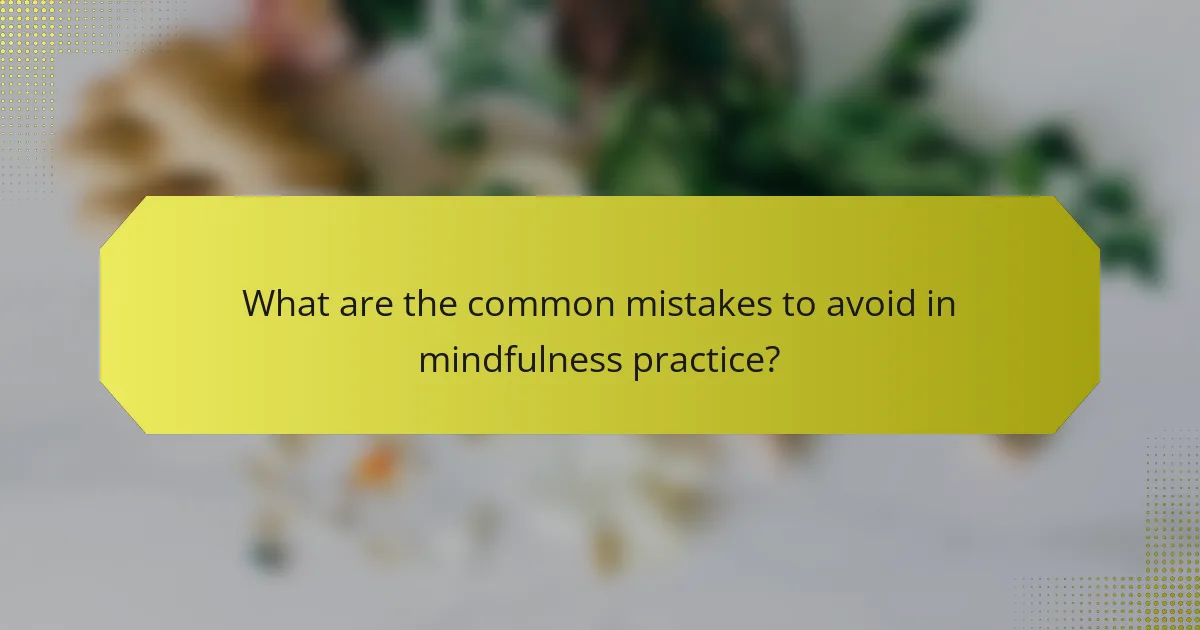
What are the common mistakes to avoid in mindfulness practice?
Common mistakes in mindfulness practice include lack of consistency, unrealistic expectations, and distractions. Practicing mindfulness sporadically undermines its benefits. Setting overly ambitious goals can lead to frustration. Engaging with distractions, such as mobile devices, detracts from the experience. Focusing on the present moment is essential for effective practice.
How can I ensure consistency in my mindfulness practice?
To ensure consistency in your mindfulness practice, establish a regular schedule and create a dedicated space for practice. Incorporate various techniques, such as meditation, breathing exercises, or mindful walking, to maintain engagement. Track your progress with a journal to reflect on experiences and adjustments. Joining a workshop can provide structure and community support, enhancing commitment.
What are the pitfalls of unrealistic expectations in mindfulness?
Unrealistic expectations in mindfulness can lead to frustration and disappointment. These pitfalls often stem from the belief that mindfulness will provide instant relief or solve deep-rooted issues. Practitioners may also overlook the gradual nature of personal growth, which can hinder their progress. Additionally, comparing one’s mindfulness journey to others can create feelings of inadequacy. Understanding these challenges is crucial for cultivating a realistic and effective mindfulness practice.
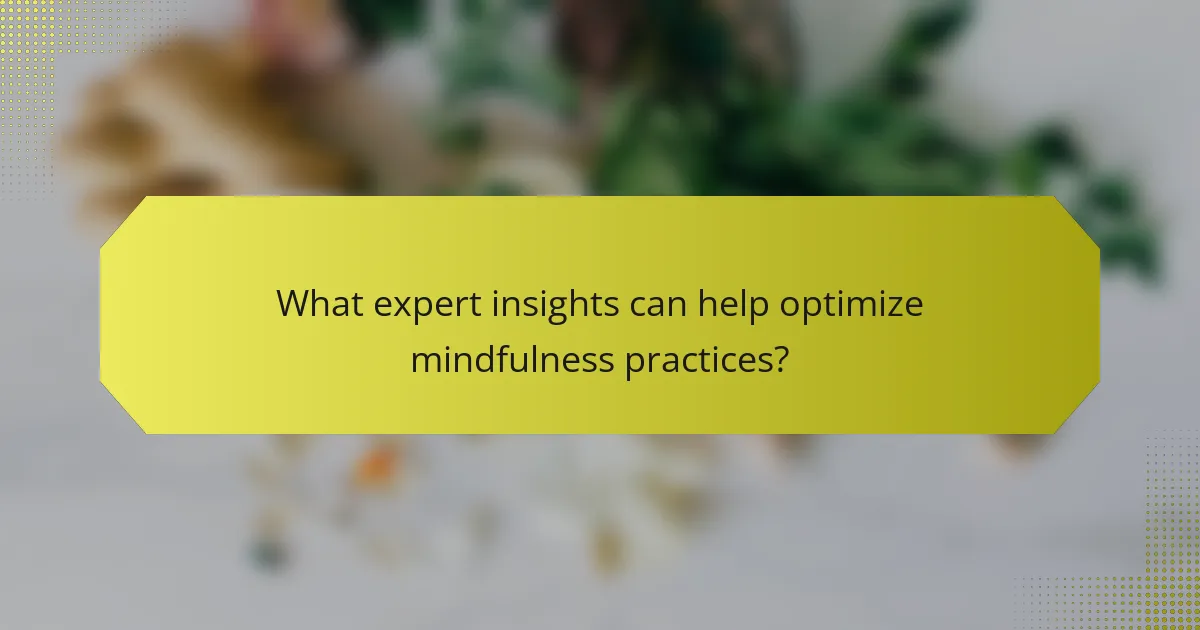
What expert insights can help optimize mindfulness practices?
Expert insights can enhance mindfulness practices by emphasizing consistency, personalization, and community engagement. Regular practice, even in short sessions, optimizes benefits like reduced stress and improved focus. Tailoring techniques to individual preferences fosters deeper connections with mindfulness. Participating in workshops creates a supportive environment, enhancing motivation and accountability.
How can I tailor mindfulness practices to my personal needs?
Tailor mindfulness practices by identifying personal goals, preferences, and challenges. Start with basic techniques like breathing exercises or guided meditations, then adapt them based on what resonates most with you.
Consider the duration and frequency of your sessions; shorter, more frequent practices may suit busy schedules. Explore various forms, such as mindfulness walking or journaling, to find what feels most engaging.
Finally, reflect on your progress regularly to adjust practices that align with your evolving needs. Personalizing mindfulness enhances its effectiveness and overall benefits.
What are the key elements of a successful mindfulness routine?
A successful mindfulness routine includes consistency, focused breathing, and self-awareness. Establishing a regular schedule fosters habit formation, while focused breathing techniques enhance relaxation. Self-awareness enables individuals to recognize thoughts and emotions, promoting mental clarity. Incorporating these elements can significantly improve overall well-being and mindfulness practice effectiveness.


